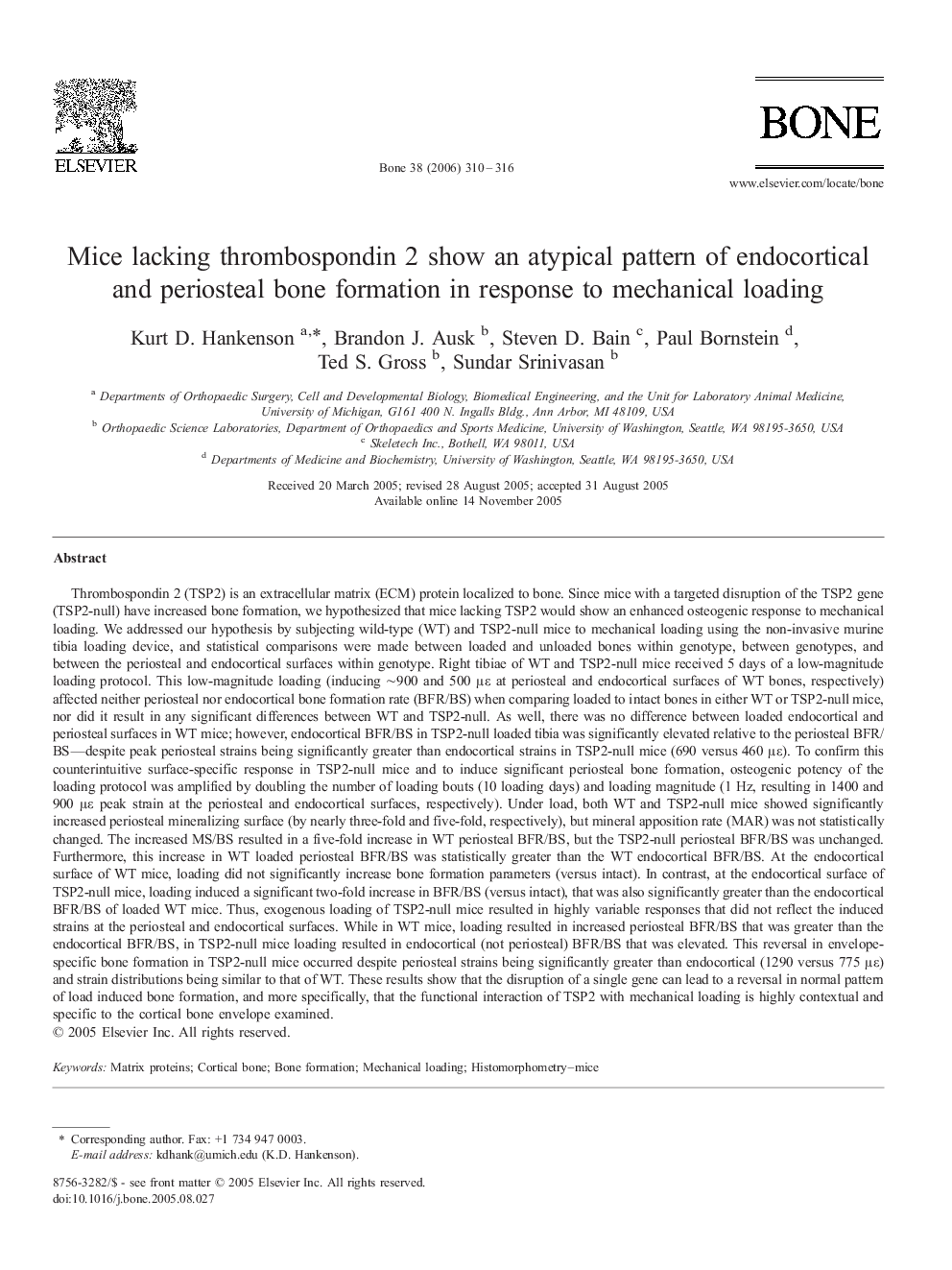| کد مقاله | کد نشریه | سال انتشار | مقاله انگلیسی | نسخه تمام متن |
|---|---|---|---|---|
| 2783054 | 1153373 | 2006 | 7 صفحه PDF | دانلود رایگان |

Thrombospondin 2 (TSP2) is an extracellular matrix (ECM) protein localized to bone. Since mice with a targeted disruption of the TSP2 gene (TSP2-null) have increased bone formation, we hypothesized that mice lacking TSP2 would show an enhanced osteogenic response to mechanical loading. We addressed our hypothesis by subjecting wild-type (WT) and TSP2-null mice to mechanical loading using the non-invasive murine tibia loading device, and statistical comparisons were made between loaded and unloaded bones within genotype, between genotypes, and between the periosteal and endocortical surfaces within genotype. Right tibiae of WT and TSP2-null mice received 5 days of a low-magnitude loading protocol. This low-magnitude loading (inducing ∼900 and 500 με at periosteal and endocortical surfaces of WT bones, respectively) affected neither periosteal nor endocortical bone formation rate (BFR/BS) when comparing loaded to intact bones in either WT or TSP2-null mice, nor did it result in any significant differences between WT and TSP2-null. As well, there was no difference between loaded endocortical and periosteal surfaces in WT mice; however, endocortical BFR/BS in TSP2-null loaded tibia was significantly elevated relative to the periosteal BFR/BS—despite peak periosteal strains being significantly greater than endocortical strains in TSP2-null mice (690 versus 460 με). To confirm this counterintuitive surface-specific response in TSP2-null mice and to induce significant periosteal bone formation, osteogenic potency of the loading protocol was amplified by doubling the number of loading bouts (10 loading days) and loading magnitude (1 Hz, resulting in 1400 and 900 με peak strain at the periosteal and endocortical surfaces, respectively). Under load, both WT and TSP2-null mice showed significantly increased periosteal mineralizing surface (by nearly three-fold and five-fold, respectively), but mineral apposition rate (MAR) was not statistically changed. The increased MS/BS resulted in a five-fold increase in WT periosteal BFR/BS, but the TSP2-null periosteal BFR/BS was unchanged. Furthermore, this increase in WT loaded periosteal BFR/BS was statistically greater than the WT endocortical BFR/BS. At the endocortical surface of WT mice, loading did not significantly increase bone formation parameters (versus intact). In contrast, at the endocortical surface of TSP2-null mice, loading induced a significant two-fold increase in BFR/BS (versus intact), that was also significantly greater than the endocortical BFR/BS of loaded WT mice. Thus, exogenous loading of TSP2-null mice resulted in highly variable responses that did not reflect the induced strains at the periosteal and endocortical surfaces. While in WT mice, loading resulted in increased periosteal BFR/BS that was greater than the endocortical BFR/BS, in TSP2-null mice loading resulted in endocortical (not periosteal) BFR/BS that was elevated. This reversal in envelope-specific bone formation in TSP2-null mice occurred despite periosteal strains being significantly greater than endocortical (1290 versus 775 με) and strain distributions being similar to that of WT. These results show that the disruption of a single gene can lead to a reversal in normal pattern of load induced bone formation, and more specifically, that the functional interaction of TSP2 with mechanical loading is highly contextual and specific to the cortical bone envelope examined.
Journal: Bone - Volume 38, Issue 3, March 2006, Pages 310–316